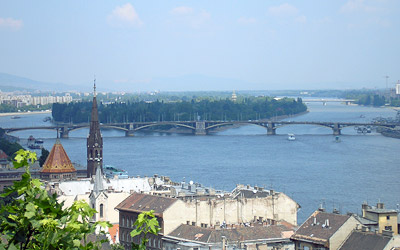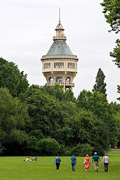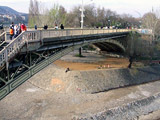Margaret Bridge
Margaret Bridge is the second permanent bridge of Budapest, a distinguished example of French Neo-Baroque bridge-building in Hungary. Its construction was started twenty years after the inauguration of the Chain Bridge. It connects Szent István Boulevard and Margit Boulevard, also touching the Margaret Island.
The design competition of the bridge was launched in May 1871. There were 43 applicants altogether, the most noted English, French, German and Austrian engineers of the epoch among them. In the end, the plans of French architect Ernest Gouin came out ahead. His own bridge-building enterprise was charged with the construction. Thanks to its elegant, unobtrusive appearance, the Parisienne-stlye arch bridge designed by Gouin forms an integral part of the surrounding landscape of Budapest.
The construction of the bridge was started in August 1872 with the building of pillar foundations. Due to the cold winter, the work had to be suspended and would only be resumed in March 1873 with the building of the central pillar, however, all foundation works had been completed by October. The iron elements forming the bridge structure had been manufactured in France and were transported to Hungary in March 1874. By October 1875, the installation of the ironwork had also been finalized, so that the bridge could be opened for traffic at 12 o'clock on 30 April 1876.

Margaret Bridge was built accordnig to French plans
The road was covered by wood-blocks, the pavements by oak flooring. The pillars and the abutments were illuminated by pompous three-pointed chandeliers. At the opening day, traffic was custom free until midnight. Initially, some booths served as provisional custom-houses. Ten years later, in 1886, however, all four permanent custom-houses had been built.
 The statues on the pillars carved by Thabard |
The bridge structure rests on seven pillars altogether: one central pillar, two riverside pillars and four riverbed pillars. Their ornated statues were carved by French sculptor Thabard in 1874. A plaque is embedded at the southern side of the central pillar, commemorating the date of the construction, as well as the name of the designer.
 Water tower on Margaret Island |
The central pillar is situated directly next to Margaret Island, one of the most-frequented week-end picnic-areas of Budapest. At this point, the bridge axis makes a 30-degree turn, so that the pillars are parallel to the channel line in both branches of the river Danube. Initially, there was no passage to Margaret Island from the bridge due to an originally larger distance between bridge and island. At that time, Margaret Island could only be reached by boat. At the end of the 19th century, however, as the regulation plan of the Danube was being carried out, Margaret Island was united with the so-called Painter Island at its southern end. Between 1899 and 1900, an additional side-bridge was built leading up to Margaret Island with a structure similar to that of the main bridge. Thus, the island became accessible by foot, too. The island, extending over the middle of river Danube, is worthily popular among the inhabitants of Budapest owing to its gorgeous Danube gardens, its tree-lined paths and flowery parks. The island is approximately 2500 meters long and 500 meters wide.
As the time had passed, the Margaret Bridge became the most congested bridge of the Hungarian capital. The horse tramway line dating from 1879 was replaced by a much heavier electric tramway line in 1894. In 1920, the demolished wood-blocks were removed and substituted by a much heavier stone pavement. All these reasons and the rapid growth of public traffic made some structural changes necessary. Between 1935 and 1937, the bridge was fortified and extended southwards, so that it became possible to place two more traffic lanes onto it.
During World War II, on 4 November 1944 the three Pest side pillars were blown up in unexplained circumstances during the afternoon rush-hours, demanding numerous victims. The Buda parts were blown up on 18 January 1945 by retreating German troops.
 The side-bridge, which connects the main bridge to Margaret Island |
In the course of the reconstruction of the bridges, the Margaret Bridge was completed as the second bridge only after Liberty Bridge. Due to its major traffic importance, the rebuilt bridge was already opened for traffic in November 1947 with only the southern lane being complete. The inauguration of whole span and the Margaret Island side-bridge took place on 1 August 1948.
The complete length of the bridge amounts to 607 meters, it is 25 meters in width. It contains four traffic lanes (two in each direction), two tramway lines in the middle and one pavement each at both sides. Tram lines 4 and 6 cross the bridge, stopping also at the middle of the bridge, at the passage to Margaret Island.
At the moment, Margaret Bridge is the worst worn bridge in Budapest. It is in urgent need of total overhaul, but the Budapest traffic would be seriously affected by the elimination of this important road. It could not be shut down until a new Northern bridge, the Megyeri Bridge was completed at the end of September 2008. According to current plans, reconstruction will be started in the first half of the year 2009. One of the most important aspects of the renovation will be the protection of the historical features of Margaret Bridge, among others the reinstallation of the sculptures that once decorated it.
|
|||||||||||||||||||||||||||||||||||||||||||
|
|||||||||||||||||||||||||||||||||||||||||||
If you are looking for a great selection of places to stay with discount prices, visit Hotel in Budapest for more information.
BRIDGES OF BUDAPEST
DID YOU KNOW?
The Buda end of Elizabeth Bridge runs straight into the foot of Gellert Hill with the statue of St. Gellert who was thrown to his death from the hill by rebellious heathens in 1046.Read more


